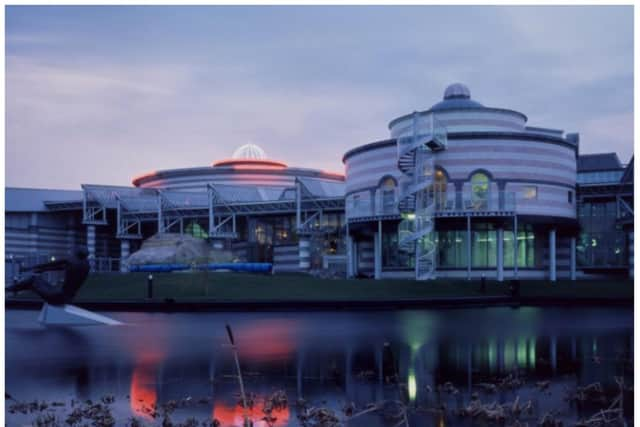Campaign launched to get Doncaster's "historic" Dome leisure centre given listed building status
and live on Freeview channel 276
The Twentieth Century Society, a campaign group dedicated to saving the country's more recent buildings, wants to secure 10 leisure centres across the UK, with the Dome among them.
The organisation says the new nationwide campaign to celebrate the architecture of the leisure centre and to protect the most historic examples.
Advertisement
Hide AdAdvertisement
Hide AdA spokesman said: “From Cornwall to the Shetland Islands, we’ve scoured the length and breadth of the UK to identify the most outstanding examples of leisure centres, submitting ten to be considered for listing to Historic England.


“Leisure centres are places of community identity and an intensely evocative part of our shared social heritage: flumes, verrucas, palm trees, the smell of chlorine, the sound of laughter - this is the backdrop to childhood experiences and families at play.
"Yet they’re also some of the most architecturally innovative structures of the late twentieth century, combining environmentally controlled environments with soaring engineering and playful pop imagery. Is there any other building-type that’s as wildly varied and downright eccentric?
"Space-age geodesic domes, diamond glazed pyramids, castellated forts, brutalist elephants and Moorish postmodern palaces.”
Advertisement
Hide AdAdvertisement
Hide AdThe Dome, which was built by architects Faulkner-Brown Hendy Watkinson Stonor between 1986 and 1989, is described as “a palace of pleasure” and impressed the Twentieth Century Society.
A spokesman said: “Another Faulkner-Browns construction, the Doncaster Dome was considered to be the firm’s most ambitious building to date, combining and refining elements from previous projects.
"It was conceived as ‘a park for the twenty-first century’ and constructed on a discarded 320-acre site on the eastern edge of the city. The building was opened in 1989 by Princess Diana and its success was such that it recorded a million visitors in 1990.
“The irregular design features many Post-Modern motifs throughout; mock pilasters adorn the health suite like a Roman baths, with banded masonry creating a polychromatic effect, drawing allusions to classical buildings like Siena Cathedral.
Advertisement
Hide AdAdvertisement
Hide Ad"Elsewhere the 650 tonnes of structural steelwork, in tapered perforated I-section columns, meet the masonry columns in a satisfying junction of old and new technologies.
"Perhaps the most striking space is the atrium: a glazed rotunda, 30m in diameter and 19m high, with striped columns around the perimeter holding up the steel oculus, described as a ‘mock Pantheon dedicated to the gods of leisure’.
“Among the attractions advertised were the largest flume ride in Britain – which meanders through the entrance mall and atrium and drops three and a half storeys over a 120m distance – plus the first experiment in a ‘leisure ice’ feature, applying the principles of a free-form pool to an ice skating rink.
"The centre’s four principal areas are all arranged around a circulation spine that encourages casual visitors to explore the building and provides window views of the various activities in progress.
Advertisement
Hide AdAdvertisement
Hide Ad"The complex was surrounded by manmade lakes and mounds to bring variety to its outdoor surroundings.
“The Dome was envisioned as an extension of the city, not an entity that was separate from it, and is still in use today. Despite the vast scale of the design, the range of spaces have avoided the need for any alterations.
"Besides minor changes to some doors and fittings, the design remains in its original form, successfully serving its original purpose.”
The spokesman added: “All are underappreciated and unexamined buildings in need of our support.
Advertisement
Hide AdAdvertisement
Hide Ad“The decimation of local authority budgets over the last decade has already forced many centres to close, with the challenges of the past couple of years only heightening the threat they now face.
"The Covid pandemic, global chlorine shortages and the soaring energy costs have meant that, in the words of Swim England’s chief executive, “Every pool is now at risk”.
A report commissioned by the national governing body in September 2021 - prior to the current energy crisis - estimated that 40% of public pools in the country (1,800+ sites) could be forced to close by 2030.
"If we don’t move to protect the most historically important examples now, they may soon disappear altogether.”
Advertisement
Hide AdAdvertisement
Hide AdC20 President Cath Slessor said: ‘With their palm trees, cafes and space frame roofs, leisure centres conjured a welcome escape from perennial British gloom, transporting you to a different, more pleasurable world. Back in my architect days, I used to work for a firm that specialised in leisure pools, so know all about the intricacies of flume geometry, waterslides and wave machines.
"Designed for exercising, socialising and for seeing and being seen, leisure centres took architecture to new and often bizarre heights of imagination. Now, sadly, many are at risk, but to lose such cherished local fixtures would diminish the communities they were designed to serve and jeopardise a rich seam of social and architectural history.’
Mike Hall of FaulknerBrowns said: “‘We are pleased to see so many FaulknerBrowns projects recognised as pioneering examples of the leisure typology.
"These buildings have all made important contributions to the communities they serve and we are proud to have been at the forefront of innovation in the sport and leisure sector since our inception. The sector now faces the challenge of considering both embodied and operational carbon over the lifecycle of our projects, in the maintenance, refurbishment or reimagining of existing buildings, as well as the design of new facilities.’